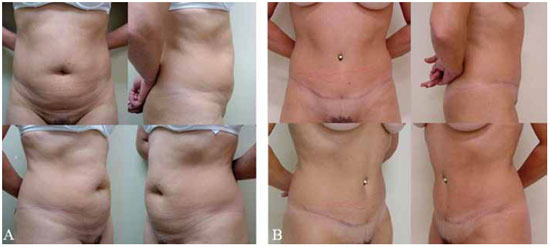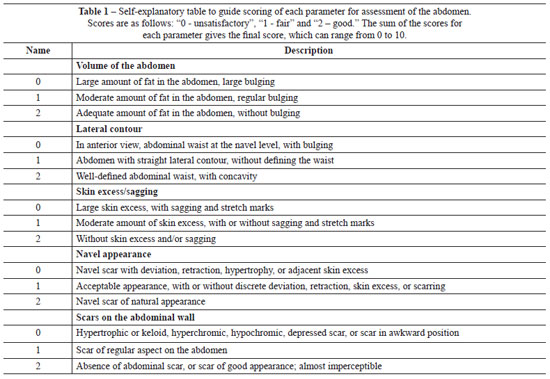

Ideas and Innovation - Year 2011 - Volume 26 -
Clinical score scale for outcomes assessment of aesthetic surgery of the abdomen
Escala para avaliação de resultados de cirurgia estética do abdome
ABSTRACT
Introduction: The standardization of outcomes assessment after aesthetic surgery is difficult in Plastic Surgery, as the assessment is based on criteria that are generally considered to be subjective. Objective: This paper aims to introduce a simple clinical score scale for outcomes assessment after aesthetic surgery of the abdomen that is easily reproducible and is based on objective criteria. Methods: The scale was developed by the Discipline of Plastic Surgery of the Hospital das Clínicas da Faculdade de Medicina, Universidade de São Paulo. The evaluator assigns a score (0 = unsatisfactory, 1 = fair, 2 = good and/or absent scar) for each of five parameters: abdomen volume, contour, skin excess, appearance of the navel, and scar quality on the abdominal wall. A framework guides the score for each parameter. Discussion: The scale is sensitive for identifying different anatomical abnormalities in the abdomen. It can be used pre-and postoperatively for comparison of various surgical techniques of abdominoplasty and liposuction, as well as to standardize outcomes for presentation at scientific conferences or in publications. The assessment can be made by means of photographs or during pre- and postoperative visits to objectively document the improvement achieved by the surgical procedure in medical records. It could also be a useful defense tool in medical-legal lawsuits.
Keywords: Outcome Assessment (Health Care). Lipectomy. Surgery, Plastic. Abdomen/surgery.
RESUMO
Introdução: A padronização da avaliação de resultados após cirurgia estética é uma dificuldade em Cirurgia Plástica, por ser baseada em critérios geralmente subjetivos. Objetivo: O objetivo deste artigo é apresentar uma escala de uso clínico simples, de fácil reprodução e que forneça critérios objetivos para a avaliação de resultados estéticos de cirurgias plásticas no abdome. Método: A escala foi desenvolvida pela Disciplina de Cirurgia Plástica da Faculdade de Medicina da Universidade de São Paulo. O avaliador dá uma nota (0 = insatisfatório, 1 = regular, 2 = bom e/ou cicatriz inexistente) para cada um de cinco parâmetros: volume do abdome, contorno lateral, excesso de pele, aspecto do umbigo e qualidade da cicatriz em parede abdominal. Um quadro orienta a pontuação para cada parâmetro. Discussão: A escala é sensível na identificação de diferentes alterações anatômicas no abdome, pode ser utilizada no pré e pós-operatório para comparação de variadas técnicas cirúrgicas, seja abdominoplastia, lipoaspiração e suas variações, ou mesmo para padronizar resultados a serem apresentados em Congressos Médicos ou publicações. A avaliação pode ser feita por fotografias ou pela própria paciente, nas consultas de pré e pós-operatório, documentando de forma objetiva em prontuário a melhora proporcionada pelo procedimento cirúrgico, ferramenta útil como defesa em processos médico-legais.
Palavras-chave: Avaliação de Resultados (Cuidados de Saúde). Lipectomia. Cirurgia Plástica. Abdome/cirurgia.
Aesthetic changes in the abdomen area are among the most frequent complaints of women. Prominent among them is the accumulation of localized fat that may have been present since adolescence, that increases with age, and undergoes post-pregnancy changes, coupled with loose skin and diastasis recti. Genetic factors, weight fluctuations, and physical inactivity also affect the aesthetic appearance of the abdomen.
Plastic surgery of the abdomen, including abdominal rectus plication, navel transposition of the detached skin flap, and completion with a scar on the skin of the lower abdominal groove, has been performed for over a century1-3. Liposuction, which was later introduced, enabled the improvement of abdominal contour without performing skin resection and is especially useful in nulliparous patients4. In the last decade, lipoabdominoplasty, a surgery that combines both procedures in a single surgical intervention, has gained in popularity5.
Despite technical advances and frequent patient satisfaction, outcomes assessment of aesthetic surgery is still difficult, does not have scientific basis, and mostly includes subjective criteria4,6. In 2000, Ferreira proposed a scale for assessing the aesthetic outcomes of breast reduction surgery based on five visual criteria: volume, shape, symmetry, areola, and scar. The scale makes the evaluator's opinion more objective, and facilitates comparative studies and statistical analysis7. This scale is also useful for outcomes assessment of breast augmentation surgery, even after weight loss. Scales such as this are simple to implement, and assessment can be performed by obtaining the patient's opinion at the time of visit, or subsequently, by means of photographic assessment8.
This study aims to present a similar scale to standardize the outcomes assessment of plastic surgery of the abdomen.
METHODS
The assessment can be performed directly with the patient or through photographs. The patient's photographs are organized on a slide. Photographs of the front, the profile, and two oblique positions taken during the preoperative period are arranged on one slide, and photographs of the patient in the same positions taken during the postoperative period are arranged on another slide. Evaluators should preferably be independent, but the patient or the surgeon can also serve as evaluators.
Scores are assigned for visual parameters such as abdominal volume, lateral contour, laxity/skin excess, navel appearance, and scar quality in the abdominal wall, and the rating scale is simplified as follows: 0 = unsatisfactory, 1 = fair, 2 = good and/or absent scar.
An explanatory table directing the assignment of scores for each parameter is provided to the evaluator (Table 1). The sum of the scores for each parameter results in a final score that ranges from 0 to 10.
Ideally, to validate the results, three plastic surgeons, who did not participate in the surgical procedure, should make an individual assessment using the scale, without identifying the patients or the assessment period (pre- or postoperative) (Figure 1). The average score can be compared between two groups that performed different techniques.

Figure 1 - The patient, 34 years of age, who underwent traditional abdominoplasty. A: Preoperative period: average score 3.67, according to independent evaluators. B: Postoperative period: average score 8.00.
DISCUSSION
Patients' expectations regarding the postoperative result of an aesthetic surgery are usually very high, and the surgeon is responsible for making them aware of the surgical limitations that result from each individual's anatomical characteristics during the preoperative period4,7. Objective, simple, and reproducible parameters, such as those used in the scale presented in this study, may assist the surgeon in this task. The five items represent the intuitive thought process of all surgeons while assessing a patient who complains of aesthetic changes in the abdomen. The content-continent ratio (amount of adipose tissue vs. the presence of excess skin), lateral contour, navel scar appearance, and the presence of scars on the abdomen, are visually assessed. The completion of this assessment can be directly performed with the patient, both before and after the surgery, objectively documenting the improvement after the surgical procedure. This type of assessment and its documentation in medical records can be useful in medical-legal lawsuits. It is common for patients to gain weight after aesthetic surgery; therefore, it may be useful to record the assessment at an early stage (for example, about three months after the procedure).
Most studies in the literature present outcomes assessment after aesthetic surgery in a subjective way, such as scales involving four degrees of cosmetic changes or a single global scale of "zero to ten"6. Kim et al.9 are of the opinion that these methods are not very reliable and contend that global scales are limited because of the use of vague terminology and that separate measures for different factors (items) of the aesthetic assessment are required for results to be more reliable.
It was also previously shown that the results of outcomes assessment through the analysis of photographs are comparable with assessments performed by physical examination of the patient. Both print and computer images are acceptable, and are less invasive assessment methods9,10.
The total assessment score of the five aspects in this scale, which ranges from 0 to 10, expresses the evaluator's satisfaction with the aesthetic appearance of the abdomen in a more standardized and objective way, irrespective of whether the evaluator is the patient or the plastic surgeon. A final score between 0 and 4 postoperatively indicates a poor outcome7. However, the aesthetic achievement relative to the initial score is more important for the analysis than the final score.
The scale presented here can be used in research studies to compare different surgical techniques, or even to standardize results presented in conferences and scientific publications.
REFERENCES
1. Callia WEP. Contribuição para o estudo da correção cirúrgica do abdome em pêndulo e globoso: técnica original [Tese de Doutorado]. São Paulo:Faculdade de Medicina, Universidade de São Paulo;1965.
2. Pitanguy I. Abdominal lipectomy: an approach to it through an analysis of 300 consecutive cases. Plast Reconstr Surg. 1967;40(4):384-91.
3. Illouz YG. Une nouvelle technique pour les lipodystrophies localisées. Rev Chir Esth Franc. 1980;6(9):Ap.
4. Saldanha OR, De Souza Pinto EB, Mattos WN Jr, Pazetti CE, Lopes Bello EM, Rojas Y, et al. Lipoabdominoplasty with selective and safe undermining. Aesthetic Plast Surg. 2003;27(4):322-7.
5. Young VL, Nemecek JR, Nemecek DA. The efficacy of breast augmentation: breast size increase, patient satisfaction, and psychological effects. Plast Reconstr Surg. 1994;94(7):958-69.
6. Strasser EJ. An objective grading system for the evaluation of cosmetic surgical results. Plast Reconstr Surg. 1999;104(7):2282-5.
7. Ferreira MC. Evaluation of results in aesthetic plastic surgery: preliminary observations on mammaplasty. Plast Reconstr Surg. 2000;106(7):1630-5.
8. Cintra Junior W. Mastopexia com inclusão de implantes mamários após tratamento cirúrgico da obesidade mórbida: avaliação da satisfação das pacientes e resultados cirúrgicos [Tese de Doutorado]. São Paulo: Universidade de São Paulo, Faculdade de Medicina;2009. 123p.
9. Kim MS, Sbalchiero JC, Reece GP, Miller MJ, Beahm EK, Markey MK. Assessment of breast aesthetics. Plast Reconstr Surg. 2008;121(4):186e-94e.
10. Christie DR, O'Brien MY, Christie JA, Kron T, Ferguson SA, Hamilton CS, et al. A comparison of methods of cosmetic assessment in breast conservation treatment. Breast. 1996;5(5):358-67.
1. PhD from the School of Medicine of Universidade de São Paulo; Coordinator of the Cosmiatry Group of the Plastic Surgery Division at Hospital das Clínicas of the School of Medicine of Universidade de São Paulo (HC-FMUSP), São Paulo, SP, Brazil.
2. Full Professor of Plastic Surgery at the School of Medicine of Universidade de São Paulo; Head of the Division of Plastic Surgery and Burns of HC-FMUSP, São Paulo, SP, Brazil.
3. Specialist by the Brazilian Society of Plastic Surgery; Medical Researcher in the Discipline of Plastic Surgery of the School of Medicine of Universidade de São Paulo, São Paulo, SP, Brazil.
4. Associate Professor of the School of Medicine of Universidade de São Paulo, São Paulo, SP, Brazil.
Corresponding author:
Alessandra Grassi Salles
Rua Joaquim Floriano, 466, cj. 2102
São Paulo, SP, Brazil - CEP 04534-002
E-mail: agsalles@uol.com.br
Submitted to SGP (Sistema de Gestão de Publicações/Manager Publications System) of RBCP (Revista Brasileira de Cirurgia Plástica/Brazilian Journal of Plastic Surgery).
Received: June 16, 2010
Accepted: July 4, 2010
Work performed at Hospital das Clínicas da Faculdade de Medicina da Universidade de São Paulo - (Hospital das Clínicas, School of Medicine, Universidade de São Paulo), São Paulo, SP, Brazil.



 Read in Portuguese
Read in Portuguese
 Read in English
Read in English
 PDF PT
PDF PT
 Print
Print
 Send this article by email
Send this article by email
 How to Cite
How to Cite
 Mendeley
Mendeley
 Pocket
Pocket
 Twitter
Twitter